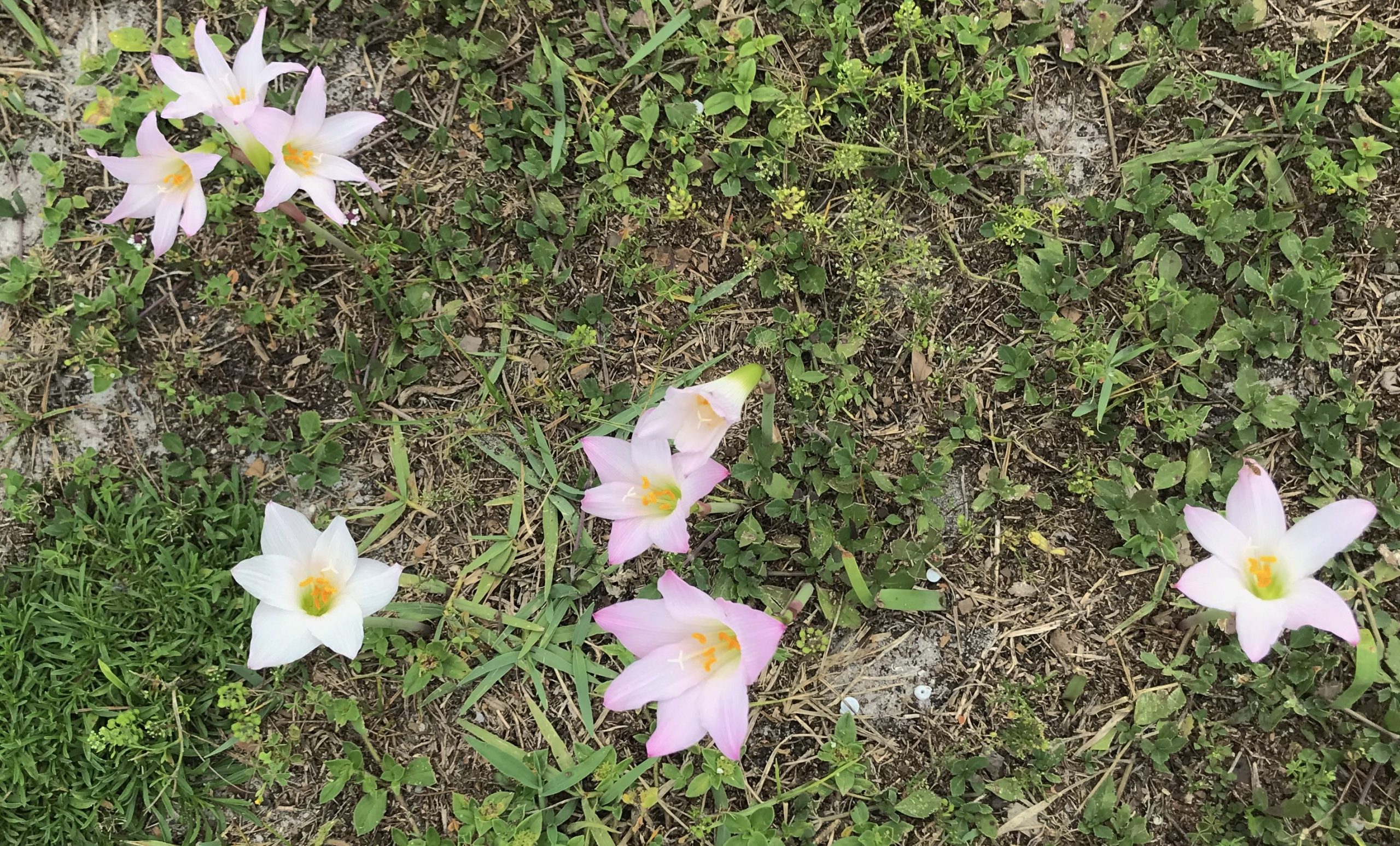
The toxic Atamasco Lily is prettying lawns now. Photo by Green Deane
The question was about coordination: When you see perennial “rain lilies” popping up in lawns, is mushroom season is starting? As we had a weekend of heavy rain – which mushroom want this time of year to get going — it’s hard to tell. At any rate the Rain Lilly aka Atamasco lilly.( Zephranthes atamasca.) are up.They are NOT edible which is good because they are a threatened species.Also sometime called Easter Lilies, Atamasca is from a Powhatan word meaning “stained with red.” Zepharanthes is from Zephyrus, which in Greek mythology is the west wind
For a threatened species they are seen in a lot of lawns this time of year prompting many emails asking for an identification. These natives like wetlands but a well-watered lawn after seasonal rains will do nicely. The problem with the Atamasco is that it resembles wild garlic before it blossoms (and even has a bulb!) However, it does not have the necessary telltale garlic or onion aroma. Remember if it smells like a garlic AND looks like a garlic you can use it like a garlic. The Atamasco does not have any garlic/onion aroma. It is not edible. All parts are poisonous. Leave it alone. And while these in the picture have a pink tinge there are also all-white blossoms.
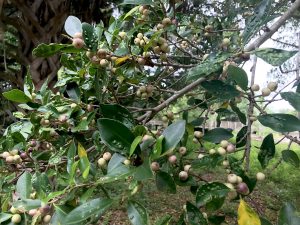
Chinese Banyan photo by Green Deane
Following up: During our foraging class in Largo an app identified a tree as a Chinese banyan. however, there are many varieties of the “Chinese banyan” Ficus microcarpa, and varieties with botanical names. It’s a fogggy genus. Most Ficus microcarpa live out their lives as house plants, — think Ficus benjamin — or as shade trees in warm municipalities. The next questions are which variety is it, is the fruit toxic and/or is the fruit edible? Sorting put figs can be difficult. And in the standard references there are no definitive answers for edibility of these figs for humans. Several references agree the sap should not get in your eyes and that the sap is toxic to dogs, cats and horses, particularly to dogs. Signs that your dog may have been after your fig tree can include heavy drooling, vomiting, and diarrhea. As for the fruit —like most banyan fruit— it generally considered more not palatable than toxic. The one I tasted was sweet. The same can be said for two strangler figs also found in Florida, one native and one not. I eat them occasionally. They can range in tast from dry sponge to fermented sour.
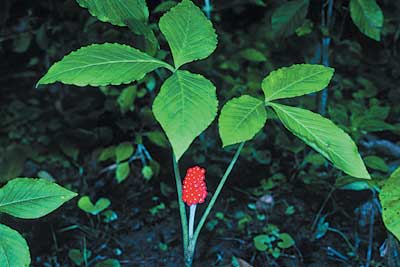
Jack in the Pulpit. Photo byGreen Deane
Jack In The Pulpit are strange plants. They’re listed among the edible species but barely. One unusual aspect about the species is they readily change sex. After reproducing they become males and do nothing but hang out on the forest floor drinking sunlight and making starch. When enough energy has been collected for reproduction — three or four years — they become females… It’s not a species that does much dating. They like damp, sun-dappled places. We see them often during foraging class in Jacksonville. They are also common along the bike trail through Big Tree Park in Sanford. To read more about Jacks and my microwave experiments with them you can go here.
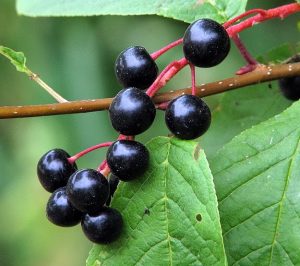
Black Cherries are both bitter and sweet.
Black Cherry has been mentioned a couple of times earlier this year and that’s the reason for it being mentioned now: It’s still fruiting. The season seems a bit longer this year than usual and I still see them here and there. It is safe to say Black Cherries look better than they taste. There is an initial cherry sweetness but then a residual bitterness takes over whereas chokecherries are bad start to finish. There were four of those trees on the other side of our lawn where I grew up in Maine. They were quite irritating: They looked wonderful but tasted awful (unless made into wine.) Black Cherries, like the chokecherries, are much better processed into jelly and wine (or cough medicine from the inner bark.) Do not eat the seeds. To read more about the Black Cherry go here.

Classes are held rain or shine (but not during hurricanes.)
Foraging classes this weekend rang from southwest Florida to near Orlando, in both locations we can identify edible roots you can eat is the food supply falls apart.
Saturday May 28th Bayshore Live Oak Park, Bayshore Drive. Port Charlotte. 9 a.m. to0 noon. Meet at the parking lot at Bayshore and Ganyard.
Sunday May 29th Mead Gardens, 1500 S. Denning Dr., Winter Park, FL 32789. 9 a.m. to noon Meet at the bathrooms.
Saturday, June 4th Boulware Springs Park, 3420 SE 15th St., Gainesville, FL 32641. 9 a.m. to noon. Meet at the picnic tables next to the pump house.
Sunday June 5th, Spruce Creek Park, 6250 Ridgewood Ave. Port Orange, 32127. 9 a.m. to noon. Meet at the pavilion.
For more information, to pre-pay or sign up go here
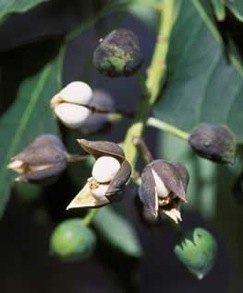
Fruit of the Chinese Tallow tree.
During a class recently I noticed the Chinese Tallow trees are blossoming. The tree poses a challenge. It has an edible fat and a toxic oil. The question is how to easily separate the two. And if “easily” is the wrong descriptor then how can it be made worth a forager’s while? The tree, Triadica sebifera, is an invasive species locally so finding a use for it would help the environment. Also as a source of fat it could literally be a life-saver in time of need because humans cannot survive without fat. In fact one can readily see the white fat (also called wax) on the seeds. It just doesn’t render easily. Each seed has a thick coating of highly saturated fat, one reason why the species is also called the popcorn tree because when in fruit it looks covered by popcorn. By all reports the outer coating is edible and has been used to make candles, hence calling it wax. In fact the tree was imported from Asia by Ben Franklin specifically to start a candle-making industry in the South. As a saturated fat the outside is very solid at room temperature. Inside the seed is a liquid oil called stillingia. It is toxic to humans.
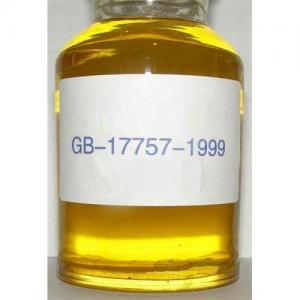
Chinese Tallow seed oil is toxic.
The “wax” is supposed to melt at 104 F. I’ve tried frying the fruit. The outer coating of fat stays solid. I’ve tried boiling. No luck. My readers have tried broiling — the seeds exploded — and micowaving, they got softer but did not melt. In China they soften the fruit in boiling water than scraped them over a fine grater. Separating the fat and the oil was also a science project. Here’s what the student did. First she bought a hand-operated oil expeller. They cost about $150 on the Internet. She put the entire fruit through the press which also heats the material. Out comes a liquid mass that upon cooling has the solid saturated fat on top and the oil on bottom. She went on to make candles out of the “wax” and used the oil in a lamp which won her three science fairs and two scholarships. Way to go! The next question we ask is whether the “wax” (saturated fat) and the oil will sufficiently separate so the fat can be used as food? Also is it just as stubborn to melt even after being processed this way? My last question would be how digestible is it? The invasive species certainly has a lot of potential. You can read more about the Chinese Tallow tree here.

Lilac blossoms are edible
Memories…For more than 60 years I have associated Lilacs with June. In rural Pownal, Maine, I attended four different one-room schools (no running water, outhouses for restrooms, and certainly no telephone. But there was a record player and the girls were in charge of playing one song after lunch… if we were good. Mrs. Tryon ruled with an iron fist.) Each school held two grades. The fifth and sixth were at the north end of the town. Directly behind that school was a wall of white Lilacs. Whenever they blossomed we knew school was soon to be over for the summer. The exact day of our release varied year to year. We always started the Tuesday after Labor Day. When we got out in June depended on how many days of school was called off during the winter because of snow or cold temperatures. So our seasonal parole date varied every year. Seeing those Lilac blossom was always a joyful time: The torture would soon be over.

Green Deane, striped shirt, front row, 1962
In the greater Olive family the most common blossom color for Lilac is … lilac. And just in case you’re interested there is a 10-day Lilac Festival in Rochester N.Y. every May (Covid notwithstanding.) Not bad for a plant with European ancestry. At the festival they have over 500 different lilacs on some 1,200 bushes. You can even sample Lilac wine. Where do I sign up? Lilac blossoms are pungent and on the lemony side. In the language of flowers — very much practiced in the 1800’s as a means of conveying information — they were assigned three meanings: The lilac Lilac humility, the purple Lilac emotional love, and the white Lilac youthful innocence. Lilacs don’t grow in Florida. Too hot and humid. Their landscaping substitute is the non-edible Crape Myrtle.
My nine-DVD set of 135 videos has been phased out and replaced by 171-videos on a 128-GB USB, see left. The USB videos are the same videos I have on You Tube. Some people like to have their own copy especially if social order falters. The USB videos have to be copied to your computer to play. If you want to order the USB go to the DVD/USB order button on the top right of this page or click here. That will take you to an order form. Or you can make a $99 donation, which tells me it is for the USB (include a snail-mail address.) I’d like to thank all of you who ordered the DVD set over the years which required me to burn over 5,000 DVDs individually. I had to stop making them as few programs now will read the ISO files to copy them. Burning a set also took about three hours.

Green Deane Forum
Want to identify a plant? Perhaps you’re looking for a foraging reference? You might have a UFO, an Unidentified Flowering Object, you want identified. On the Green Deane Forum we — including Green Deane and others from around the world — chat about foraging all year. And it’s not just about warm-weather plants or just North American flora. Many nations share common weeds so there’s a lot to talk about. There’s also more than weeds. The reference section has information for foraging around the world. There are also articles on food preservation, and forgotten skills from making bows to fermenting food. Recent topics include: Fermenting potatoeswith yogurt, make a water filter, nixtamalization at home, Stale Bread and Cod Liver Oil, Life’s a Grind, Killing Bugs with Tobacco Plugs, Eating weeds: Is it safe? Have they mutated? Not the Eastern Red Bug but the Pink Tabebuia, African Tulip Tree, Asparagus densiflorus, Green Deane’s Book… You can join the forum by clicking on the button on the upper right hand side of this page.
This is my weekly newsletter #509. If you want to subscribe to this free newsletter you can find the sign-up form in the menu at the top of the page. My website, EatTheWeeds.com, which is data secure, has over 1500 plants on it in some 428 articles. I wrote every one myself, no cut and paste.
To donate to the Green Deane Newsletter click here.


My husband is from Maine, after being married to him 30 years finally he took me to Maine (( ok I had to pay for the whole trip and buy a van to get him to go)) All our marriage hes talked about Lilacs, course in Florida we don’t have Lilacs. So he bought buys me a very expensive Lilac perfume that he often gets out of my bathroom to spray around the house so he can smell the Lilacs. Its a real special day for him when I actually wear the Lilac. LOL !!!!
Lilacs remind me of our prosperous time in lovely Khartoum – Sudan – in the seventies last cetuary . At that time our famous singer Sayyid khalifa had a song on Lilacs . Indeed a factory had been established in Khartoum North for making “Lilac” toilet soap .